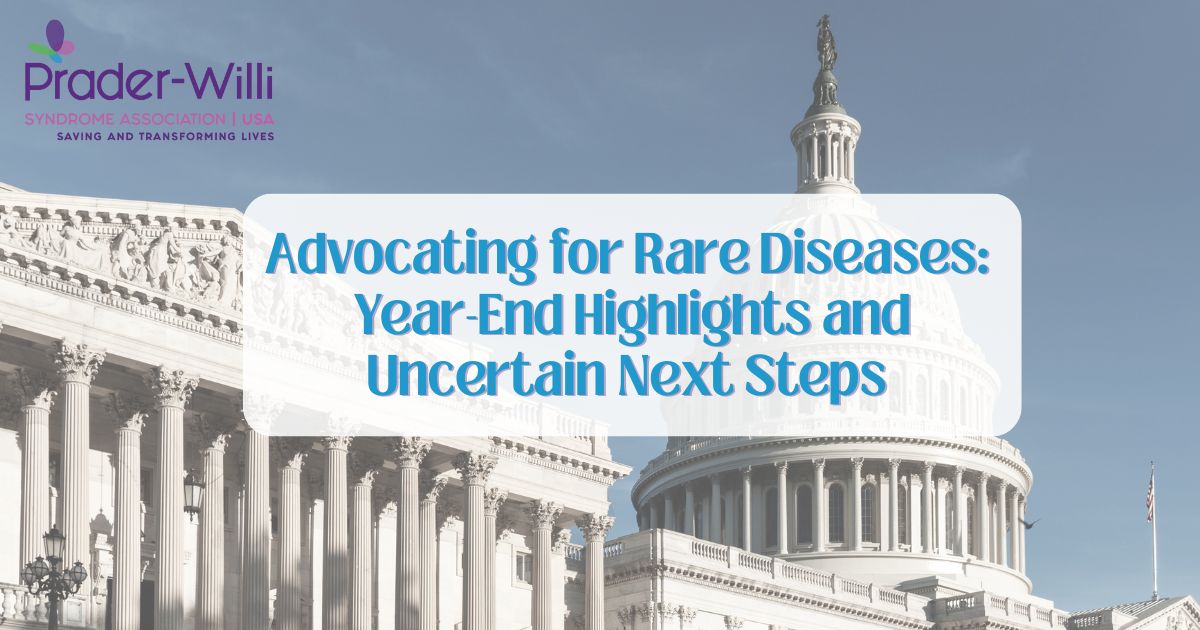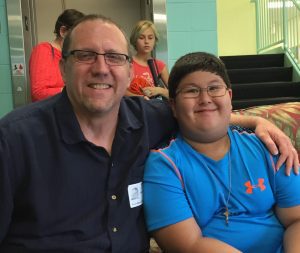Dorothea Lantz, PWSA | USA Community Engagement Director, and Elaine Towle, PWSA | USA volunteer advocate, recently represented the rare disease community in critical meetings on Capitol Hill with Sen. Shaheen, Sen. Hassan, Sen. Rubio, and Sen. Braun. These discussions emphasized advancing legislative priorities for 2025, including rare disease drug development, improving Medicaid access for children, and addressing prescription drug affordability.
They also attended the Community Congress Annual In-Person Meeting hosted by the Rare Disease Legislative Advocates (RDLA), where more than 150 members gathered at the National Press Club on December 12, 2024.
The meeting featured expert panel discussions, strategic roundtables, and reflections on the community’s accomplishments in 2024.

Community Congress Meeting Highlights
– 2024 Policy Recap: The EveryLife Foundation reviewed impactful policy achievements, working group contributions, and improvements in community engagement.
– 2025 Policy Outlook: A panel of health policy experts shared strategies for optimizing advocacy efforts in the new Congress and Administration, with actionable insights to be published in the RDLA Portal.
– Agency Leaders’ Priorities: Representatives from ARPA-H, FDA, and NIH outlined goals for rare disease research and encouraged engagement with FDA’s Rare Disease Innovation Hub, led by Amy Comstock Rick starting January 2025.
– Strategic Roundtables: Discussions covered transitional care, payer engagement, newborn screening, orphan drug incentives, and infrastructure for rare disease therapy implementation. Emerging topics, such as transitional care, were highlighted as critical areas for advocacy.
– A Bipartisan Health Package in Limbo: The healthcare package negotiated as part of the Continuing Resolution (CR) has been significantly dismantled. Hopes were high for Congress to pass the bipartisan package before the holiday recess, but at the time of writing, its future remains uncertain.
What’s Left in the CR:
– Telehealth Waivers: Medicare pandemic-era telehealth flexibilities are extended through March 31, 2025.
– Community Health Funding: Funding for Community Health Centers, the National Health Service Corps, and Teaching Health Centers is reauthorized through March 31, 2025.
What’s Been Lost:
– Reauthorization of the Rare Pediatric Disease PRV Program.
– PBM reform provisions, including Medicaid transparency requirements and a ban on spread pricing.
– SUPPORT Act Reauthorization
– Medicare provider payment increases.
– Medicaid provider enrollment streamlining for out-of-state care under the Accelerating Kids’ Access to Care Act.
Next Steps
Late in the evening on December 19th, Congress voted down the revised Continuing Resolution (CR). As of the time this article was written, the future of the CR remains uncertain. Lawmakers now face limited time to negotiate a new agreement before the holiday recess. The failure of this vote leaves critical healthcare provisions, including those benefiting the rare disease community, in limbo.
While it’s unclear what will happen next, advocates and stakeholders are continuing to push for meaningful reforms to be included in any future package. The rare disease community must remain engaged and ready to advocate as developments unfold.
What Does This Mean?
The removal of key healthcare provisions is a major setback, particularly for the rare disease community. If the stripped-down CR passes, lawmakers will need to restart work in the 119th Congress on critical priorities such as PRV reauthorization, PBM reform, and Medicaid access improvements.
Despite this uncertainty, the rare disease community remains committed to advancing these priorities. The PWS and entire rare community has laid a strong foundation for collaborative advocacy in 2025, emphasizing the importance of partnerships, transitional care, and infrastructure to drive policy change.
Your continued engagement is essential as we navigate these challenges and prepare for the work ahead. Together, we’ll ensure rare diseases remain a priority in healthcare policy.
Share this!





 Jennifer Bolander has been serving as a Special Education Specialist for PWSA (USA) since October of 2015. She is a graduate of John Carroll University and lives in Ohio with her husband Brad and daughters Kate (17), and Sophia (13) who was born with PWS.
Jennifer Bolander has been serving as a Special Education Specialist for PWSA (USA) since October of 2015. She is a graduate of John Carroll University and lives in Ohio with her husband Brad and daughters Kate (17), and Sophia (13) who was born with PWS. Perry A. Zirkel has written more than 1,500 publications on various aspects of school law, with an emphasis on legal issues in special education. He writes a regular column for NAESP’s Principal magazine and NASP’s Communiqué newsletter, and he did so previously for Phi Delta Kappan and Teaching Exceptional Children.
Perry A. Zirkel has written more than 1,500 publications on various aspects of school law, with an emphasis on legal issues in special education. He writes a regular column for NAESP’s Principal magazine and NASP’s Communiqué newsletter, and he did so previously for Phi Delta Kappan and Teaching Exceptional Children. Evan has worked with the Prader-Willi Syndrome Association (USA) since 2007 primarily as a Crisis Intervention and Family Support Counselor. Evans works with parents and schools to foster strong collaborative relationships and appropriate educational environments for students with PWS.
Evan has worked with the Prader-Willi Syndrome Association (USA) since 2007 primarily as a Crisis Intervention and Family Support Counselor. Evans works with parents and schools to foster strong collaborative relationships and appropriate educational environments for students with PWS. Dr. Amy McTighe is the PWS Program Manager and Inpatient Teacher at the Center for Prader-Willi Syndrome at the Children’s Institute of Pittsburgh. She graduated from Duquesne University receiving her Bachelor’s and Master’s degree in Education with a focus on elementary education, special education, and language arts.
Dr. Amy McTighe is the PWS Program Manager and Inpatient Teacher at the Center for Prader-Willi Syndrome at the Children’s Institute of Pittsburgh. She graduated from Duquesne University receiving her Bachelor’s and Master’s degree in Education with a focus on elementary education, special education, and language arts. Staci Zimmerman works for Prader-Willi Syndrome Association of Colorado as an Individualized Education Program (IEP) consultant. Staci collaborates with the PWS multi-disciplinary clinic at the Children’s Hospital in Denver supporting families and school districts around the United States with their child’s Individual Educational Plan.
Staci Zimmerman works for Prader-Willi Syndrome Association of Colorado as an Individualized Education Program (IEP) consultant. Staci collaborates with the PWS multi-disciplinary clinic at the Children’s Hospital in Denver supporting families and school districts around the United States with their child’s Individual Educational Plan. Founded in 2001, SDLC is a non-profit legal services organization dedicated to protecting and advancing the legal rights of people with disabilities throughout the South. It partners with the Southern Poverty Law Center, Protection and Advocacy (P&A) programs, Legal Services Corporations (LSC) and disability organizations on major, systemic disability rights issues involving the Individuals with Disabilities Education Act (IDEA), Americans with Disabilities Act (ADA), and the federal Medicaid Act. Recently in November 2014, Jim retired.
Founded in 2001, SDLC is a non-profit legal services organization dedicated to protecting and advancing the legal rights of people with disabilities throughout the South. It partners with the Southern Poverty Law Center, Protection and Advocacy (P&A) programs, Legal Services Corporations (LSC) and disability organizations on major, systemic disability rights issues involving the Individuals with Disabilities Education Act (IDEA), Americans with Disabilities Act (ADA), and the federal Medicaid Act. Recently in November 2014, Jim retired.